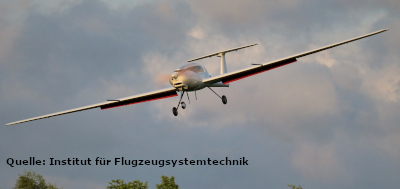G-FLIGHTS

Within G-FLIGHTS several systems for the alleviation of structural loads due to manoeuvre and gusts are developed and validated in flight tests.
G-FLIGHTS aims on the development of systems for the alleviation of discrete structural loads as they occur in flight. Those systems will be validated and assessed in flight tests. For the project a consortium with the Institute for Aircraft Systems Engineering (FST) of Hamburg University of Technology (TUHH) is formed.
The concept of load alleviation is a further improvement of the electronic flight control system (EFCS) which assists the pilot guiding the aircraft and avoiding dangerous flight conditions. By addressing structural loads in flight controls the structural capacities can be used more efficiently. These loads typically follow certain manoeuvre conditions or encounters with gusts or turbulence. In particular the effects on the structure of the wings and the empennage are of interest. Further benefits are an increased manoeuvrability of the aircraft and improved passenger comfort following external disturbances.
For the realisation of such control systems a complete aeroelastic model of the considered aircraft, a model of the HK36 “Super Dimona” maintained by the project partner, is developed. Theoretic structural and aerodynamic models are adjusted to experimental data derived from ground vibration and flight tests. Therefore, the aircraft is equipped with instruments for the measurement of flight physical parameters and structural loads.
The systems which are developed in the framework of G-FLIGHTS are of different complexity aiming for short- and long-term applicability in industrial contexts. In contrast to state-of-the-art solutions the new approaches are based on a data-driven or model-based estimation of the occurring loads. Up until now load alleviation systems are triggered by load indicating parameters, e.g. the loadfactor. Therefore, on the one hand, IBK tests the existing load alleviation system based on an estimate of the load parameter of interest itself. Secondly, a model predictive approach is developed in which control surface deflections are implemented which are generated from a model based optimisation regarding structural loads. In order to validate the approaches, they are implemented to the test aircraft and their performance in flight test will be assessed.
Partners:
G-FLIGHTS runs from 01/2016 tilll 09/2019 and is funded in the framework of the national aeronautic research program (LuFo V.2).
